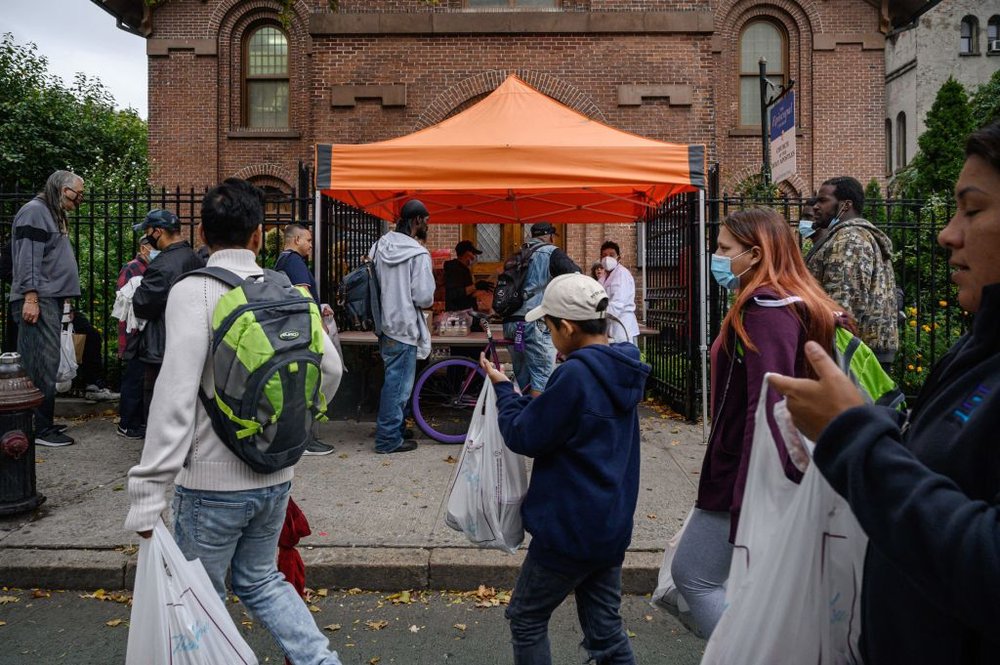NYC rate of processing food stamp, cash assistance applications hits record lows
Sept. 20, 2023, 5 a.m.
SNAP, the federally-funded program is a lifeline for low-income residents and required to be processed in 30 days.

New York City’s rate of processing food stamp and cash assistance applications within the required 30 days took a precipitous plunge last fiscal year — setting the worst record in more than a decade and leaving thousands of low-income residents waiting extra long for help, newly released city data shows.
That means the most vulnerable New Yorkers are waiting more than a month to access two crucial public assistance programs that serve as a lifeline amid record high rents, rising food prices and the end of the eviction moratorium.
“It’s shocking and outrageous that the numbers have gotten to this point,” said Katie Kelleher, a staff attorney with the The Legal Aid Society. “This is something the city used to know how to do; the city in the past was able to timely provide benefits to people.”
The mayor’s management report — a kind of yearly report card on city agencies — shows the Human Resources Administration has processed most food stamp and cash assistance applications within federal- or state-mandated deadlines for the last decade or more. Fiscal year 2023, which runs from July 1 to June 30, is a stark outlier.
HRA, which is part of the city’s Department of Social Services, processed 39.7% of applications to the Supplemental Nutrition Assistance Program benefits, known as SNAP, within 30 days, the lowest rate since 2006, when the city began including these numbers in the mayor’s management report. Prior to the 2023 fiscal year, processing rates never dropped below 80%, the reports show.
Processing rates for cash assistance applications saw an even steeper nose dive.
HRA processed 28.8% of applications within 30 days, as required by the state — compared to 82.3% the prior fiscal year, making it the lowest rate since 2010. City officials attributed the stark change to the state changing the processing deadline for some applicants last year from 45 days to 30 days.
A DSS spokeswoman said average caseloads for both programs were the highest in the last five years.
The agency “helped more New Yorkers receive these critical benefits than in recent years, including pre-pandemic years,” spokeswoman Neha Sharma said. “DSS continues to aggressively hire, train, and redeploy staff, implement process improvements, and streamline our highly effective remote processes to bolster cash assistance and SNAP processing and ultimately get these benefits to New Yorkers in a timely manner.”
More than 1.7 million people are receiving SNAP benefits as of July, according to Sharma compared to 1.5 million in 2019 before the pandemic began. Cash assistance applications alone increased 30% in fiscal year 2023 compared to the year before and were the highest since at least 2008. As of July, 489,000 people were receiving cash assistance benefits, compared to about 330,000 in 2019, city numbers show.
The city also attributed increased delays to high attrition and retirement rates among staff, according to the annual report.
“At a certain point it has to be something the city adjusts to, because they are required to,” said Abby Biberman, an associate director at the New York Legal Assistance Group. “It’s not a blip, it’s continuing.”
But Kelleher said the change in processing times wasn’t surprising and the numbers from the agency are a way to evaluate the city’s compliance with current timeliness rules.
“The city needs to fix this,” Kelleher said. “What they're really doing is hurting people and people can't eat retroactively.”
David Greenfield, CEO of Met Council, a nonprofit focused on assisting low-income New Yorkers, said more people than ever before are struggling to make ends meet, all while the city contends with low staffing levels. A 2023 report by the city comptroller found a 15% vacancy in the HRA.
“You have more people who need help and you have less people who can help them,” he said. “Realities of inflation, the cost of groceries have gone up, the cost of your gas has gone up, the cost of your electric bill has gone up, the cost of your rent has gone up, and the cost of your food has gone up, and incomes have not kept up on par with that.”
Greenfield said his food pantries have seen a 25% increase in residents seeking services in the last year.
“I'm less concerned about the technical aspects of how long it takes to get a benefit than I am about the reality that more New Yorkers need that benefit than ever before,” Greenfield said.
“More New Yorkers are suffering today than they were pre-pandemic, and that is directly as a result of decisions that were made, predominantly, by the federal government, where a lot of these key programs that lifted people out of poverty have disappeared, and people have now fallen back into poverty,” he added.
The federal government stopped giving SNAP recipients an extra $95 a month in March, and in 2021 stopped additional pandemic unemployment benefits.
The city has until March 2024 to comply with a federal court order, stemming from a class action lawsuit filed by The Legal Aid Society and theNew York Legal Assistance Group over processing delays in SNAP and cash assistance benefits.
The injunction requires the city to meet 30-day deadlines to process applications and also respond to recertifications – renewals that recipients have to file to re-up their benefits – within required deadlines.